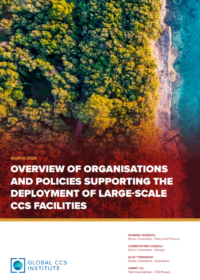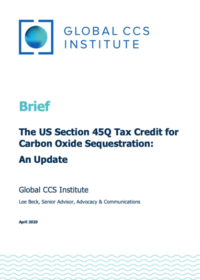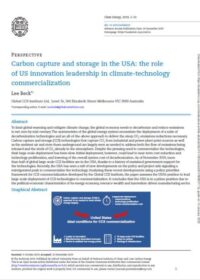リソース
刊行物、報告書および研究調査
検索条件
Overview of Organisations and Policies Supporting the Deployment of Large-Scale CCS Facilities
30th June 2020
Organisation(s): Global CCS Institute
Topic(s): CCS policy
While there are currently relatively few CCS facilities in operation and in development, there are significant differences in the enabling environments for CCS deployment. This report explores the potential role of Delivery Bodies to help enable the deployment of CCS. It also provides an overview of the organisations involved in the deployment of large-scale CCS facilities, and the policy and regulatory frameworks that have supported this deployment.
Disclaimer
The content within the Global CCS Institute Publications, Reports and Research Library is provided for information purposes only. We make every effort and take reasonable care to keep the content of this section up-to-date and error-free. However, we make no claim as to its accuracy, currency or reliability.
Content and material featured within this section of our website includes reports and research published by third parties. The content and material may include opinions and recommendations of third parties that do not reflect those held by the Global CCS Institute.
Carbon capture and storage (CCS) is needed as part of the toolkit of technologies to achieve net-zero emissions by mid-century. Yet, texts and commentary about CCS often include qualifiers that are related to the expenditures necessary to deploy it; ‘costly’, ‘exorbitantly expensive’, ‘unaffordable’, ‘uneconomical’. As such, the argument most often brought forward against deployment of CCS is that it is an expensive way of reducing emissions.
This brief written by our Senior Advisors for Advocacy and Communications Lucy Temple-Smith and Lee Beck demonstrates that:
- To reach net-zero emissions by mid-century and achieve global climate change targets all decarbonisation options are needed.
- Carbon capture and storage (CCS) plays an important role reducing emissions to net-zero and limiting the overall system cost of decarbonisation.
- With versatile applications, CCS cost differs across its variety of industrial and power-related applications – there is no singular cost of CCS.
- Considering the urgency of the climate crisis, cost should not be a deterrent to investing in CCS nor dictate sequencing of the deployment of decarbonisation options. Instead, deployment will lead to cost reductions.
- A value on carbon is needed to support the business case for large-scale CCS deployment and overcome the technology ‘valley of death’.
Disclaimer
The content within the Global CCS Institute Publications, Reports and Research Library is provided for information purposes only. We make every effort and take reasonable care to keep the content of this section up-to-date and error-free. However, we make no claim as to its accuracy, currency or reliability.
Content and material featured within this section of our website includes reports and research published by third parties. The content and material may include opinions and recommendations of third parties that do not reflect those held by the Global CCS Institute.
In recent decades, Southeast Asia has been one of fastest growing regions of the world. Its energy demand has grown more than 80 per cent from 2000. Oil, coal and gas provides more than 70 per cent of its energy. With the region’s power generation fuel mix and rapidly growing natural gas production, alongside established and emerging emissions reduction committments, CCS has a unique and critical role to play.
In this paper, Institute’s Senior Client Engagement Lead Dr Tony Zhang, discusses why Southeast Asia needs CCS, the specific drivers behind the opportunities for accelerated deployment and the critical role of CCS hub and cluster networks in reducing the region’s emissions.
Disclaimer
The content within the Global CCS Institute Publications, Reports and Research Library is provided for information purposes only. We make every effort and take reasonable care to keep the content of this section up-to-date and error-free. However, we make no claim as to its accuracy, currency or reliability.
Content and material featured within this section of our website includes reports and research published by third parties. The content and material may include opinions and recommendations of third parties that do not reflect those held by the Global CCS Institute.
The new flagship Global CCS Institute thought leadership report analyzes the major benefits of the large-scale investment and deployment of CCS and discusses the existing evidence related to the value of CCS under two overarching themes.
CCS as an essential technology to economically meet long-term climate targets and for risk mitigation through:
- Achieving deep decarbonisation in hard-to-abate industry;
- Enabling the production of clean hydrogen at scale;
- Providing low-carbon dispatchable power;
- Delivering negative emissions.
CCS is a driver of economic growth and employment by:
- Creating and sustaining jobs;
- Supporting economic growth through new net-zero industries and innovation spillovers;
- Facilitating a just transition by alleviating geographic and timing mismatches;
- Enabling infrastructure reuse and deferral of decommissioning costs.
This report was authored by the Institute’s Senior Consultant – Economics Alex Townsend and Research Analyst Nabeela Raji, as well as the Institute’s General Manager – Commercial, Alex Zapantis. You can tweet about the report using #ValueCCS.
Disclaimer
The content within the Global CCS Institute Publications, Reports and Research Library is provided for information purposes only. We make every effort and take reasonable care to keep the content of this section up-to-date and error-free. However, we make no claim as to its accuracy, currency or reliability.
Content and material featured within this section of our website includes reports and research published by third parties. The content and material may include opinions and recommendations of third parties that do not reflect those held by the Global CCS Institute.
Organisation(s): Global CCS Institute
Topic(s): ccs, Energy, Oil and Gas, Transition
As oil and gas companies are evolving their business models in the context of the energy transition, and a growing number of them are committing to net-zero targets, CCS has started to feature more prominently in their strategies and investments.
In this paper, Institute’s General Manager Guloren Turan discusses how CCS can support the oil and gas industry’s low-carbon transition and addresses current developments and opportunities in applications including gas processing, enhanced oil recovery, ethanol production, refining, low-carbon hydrogen production, gas-fired power generation, and direct air capture.
Disclaimer
The content within the Global CCS Institute Publications, Reports and Research Library is provided for information purposes only. We make every effort and take reasonable care to keep the content of this section up-to-date and error-free. However, we make no claim as to its accuracy, currency or reliability.
Content and material featured within this section of our website includes reports and research published by third parties. The content and material may include opinions and recommendations of third parties that do not reflect those held by the Global CCS Institute.
Organisation(s): Global CCS Institute
Topic(s): Carbon capture, Carbon markets, Carbon removal, ccs, Policy
There has been a growing interest within the Institute’s membership – and elsewhere – in the opportunities to drive the deployment of CCS by the provisions of Article 6 of the Paris Agreement. This paper draws together all the latest information and thinking on the Article and its role in enabling countries to meet the objectives they have set themselves in their Nationally Determined Contributions (NDCs), with particular emphasis on how it can impact CCS.
The paper, authored by our Senior Policy Advisor Eve Tamme and Consultant John Scowcroft, provides insights into the history of Article 6, elaborates on how it can be an enabler for CCS, and looks into the upcoming developments in this field by answering the following questions:
• What does Article 6 do?
• What does Article 6 not do?
• Where is Article 6 in the international climate negotiations?
• What does Article 6 mean for CCS?
• What are the next steps?
Disclaimer
The content within the Global CCS Institute Publications, Reports and Research Library is provided for information purposes only. We make every effort and take reasonable care to keep the content of this section up-to-date and error-free. However, we make no claim as to its accuracy, currency or reliability.
Content and material featured within this section of our website includes reports and research published by third parties. The content and material may include opinions and recommendations of third parties that do not reflect those held by the Global CCS Institute.
Organisation(s): Global CCS Institute
Topic(s): ccs, CCS Facilities, Policy
Understanding how the CCS market is likely to develop over the coming years is of interest to a wide range of stakeholders. It can help inform the timing and design of policies introduced by governments, the scale of the market for potential investors, and the challenges associated with meeting long-term climate targets.
This report aims to inform the discussion on these topics by providing an overview of the near-term and longer-term developments in the CCS market.
It reviews the current CCS facility pipeline, and how that could change in the next few years given project lead-in times. It then considers how this compares to projections of the number of CCS facilities needed to meet long-term climate goals. Throughout the report the number of CCS facilities deployed is used as a proxy for the size of the CCS market.
Disclaimer
The content within the Global CCS Institute Publications, Reports and Research Library is provided for information purposes only. We make every effort and take reasonable care to keep the content of this section up-to-date and error-free. However, we make no claim as to its accuracy, currency or reliability.
Content and material featured within this section of our website includes reports and research published by third parties. The content and material may include opinions and recommendations of third parties that do not reflect those held by the Global CCS Institute.
In February 2020, the US Internal Revenue Service published Notice 2020-12 and Revenue Procedure 2020-12, which include updated guidance regarding the Section 45Q Credit. Among other areas, this notice focuses on the eligibility requirements for the date of construction commencement and partnership structures.
Our Washington, DC-based Senior Advisor for Advocacy and Communications, Lee Beck, has prepared an Issue Brief on the latest developments.
Disclaimer
The content within the Global CCS Institute Publications, Reports and Research Library is provided for information purposes only. We make every effort and take reasonable care to keep the content of this section up-to-date and error-free. However, we make no claim as to its accuracy, currency or reliability.
Content and material featured within this section of our website includes reports and research published by third parties. The content and material may include opinions and recommendations of third parties that do not reflect those held by the Global CCS Institute.
Launched at COP25 in December 2019, our Global Status of CCS 2019 Report provides a comprehensive review of the status of CCS globally. The 2019 report documents the current status of CCS around the world and the significant operational milestones over the past 12 months. The report tracks the worldwide progress of CCS technologies and the key opportunities and challenges it faces. insights from our experts, and a range of CCS Case Studies from around the world.
You can download the Report here.
Disclaimer
The content within the Global CCS Institute Publications, Reports and Research Library is provided for information purposes only. We make every effort and take reasonable care to keep the content of this section up-to-date and error-free. However, we make no claim as to its accuracy, currency or reliability.
Content and material featured within this section of our website includes reports and research published by third parties. The content and material may include opinions and recommendations of third parties that do not reflect those held by the Global CCS Institute.
The Global CCS Institute is pleased to present a Brief for Policymakers: CCS - Targeting Climate Change.
The brief summarizes the key findings of the Institute's latest Global Status of CCS Report which documents a range of important milestones for CCS, its status across the world and the key opportunities and benefits the technology presents.
The Brief includes detailed information on:
- CCS and its role in climate mitigation
- CCS deployment around the world
- the role of policy in large-scale deployment and
- updates on the progress, projects, and policies globally.
We hope you enjoy it, share it with colleagues and look forward to working with you as we accelerate the deployment of carbon capture and storage globally.
Disclaimer
The content within the Global CCS Institute Publications, Reports and Research Library is provided for information purposes only. We make every effort and take reasonable care to keep the content of this section up-to-date and error-free. However, we make no claim as to its accuracy, currency or reliability.
Content and material featured within this section of our website includes reports and research published by third parties. The content and material may include opinions and recommendations of third parties that do not reflect those held by the Global CCS Institute.
2020 Perspective : The European Green Deal: New opportunities to scale up carbon capture and storage
27th February 2020
The recent reports of the Intergovernmental Panel on Climate Change (IPCC), and the Commission vision for a climate neutral Europe , have mobilised support for climate neutrality by 2050 by most EU Member States. Balancing sources and sinks by 2050, and from that point onwards achieving net negative emissions, can only be delivered through a major economy-wide transformation and by substantially stepping up the use of all climate change mitigation and carbon removal technologies. The European Green Deal as the new big European project is an enormous challenge but also an opportunity to lead by example and transform the European economy.
This overview takes a closer look at the European Green Deal with its extensive list of initiatives, and highlights what to watch out for in the coming days, months and years regarding low carbon technologies like carbon capture and storage (CCS). This paper explores how climate targets, governance, just transition, carbon border adjustment, industrial strategy, hydrogen, financing and infrastructure can support CCS technologies. The second part of the paper highlights the three main challenges for CCS in the existing legislation that need to be considered in the upcoming wave of revisions and new initiatives.
It’s a snapshot of where we are as of February 2020, with a list of initiatives and processes to choose from when engaging with policymakers and stakeholders.
This piece was authored by Eve Tamme, Senior Advisor for Climate Change Policy at the Global CCS Institute.
Disclaimer
The content within the Global CCS Institute Publications, Reports and Research Library is provided for information purposes only. We make every effort and take reasonable care to keep the content of this section up-to-date and error-free. However, we make no claim as to its accuracy, currency or reliability.
Content and material featured within this section of our website includes reports and research published by third parties. The content and material may include opinions and recommendations of third parties that do not reflect those held by the Global CCS Institute.
Carbon capture and storage in the USA: the role of US innovation leadership in climate-technology commercialization
16th January 2020
To limit global warming and mitigate climate change, the global economy needs to decarbonize and reduce emissions to net-zero by mid-century. The asymmetries of the global energy system necessitate the deployment of a suite of decarbonization technologies and an all-of-the-above approach to deliver the steep CO2-emissions reductions necessary. Carbon capture and storage (CCS) technologies that capture CO2 from industrial and power-plant point sources as well as the ambient air and store them underground are largely seen as needed to address both the flow of emissions being released and the stock of CO2 already in the atmosphere. Despite the pressing need to commercialize the technologies, their large-scale deployment has been slow.
Initial deployment, however, could lead to near-term cost reduction and technology proliferation, and lowering of the overall system cost of decarbonization. As of November 2019, more than half of global large-scale CCS facilities are in the USA, thanks to a history of sustained government support for the technologies. Recently, the USA has seen a raft of new developments on the policy and project side signaling a reinvigorated push to commercialize the technology. Analysing these recent developents using a policy-priorities framework for CCS commercialization developed by the Global CCS Institute, this paper by Lee Beck, our US-based Senior Advisor for Advocacy and Communications, assesses the USA’s position to lead large-scale deployment of CCS technologies to commercialization. It concludes that the USA is in a prime position due to the political economic characteristics of its energy economy, resource wealth and innovation-driven manufacturing sector.
Disclaimer
The content within the Global CCS Institute Publications, Reports and Research Library is provided for information purposes only. We make every effort and take reasonable care to keep the content of this section up-to-date and error-free. However, we make no claim as to its accuracy, currency or reliability.
Content and material featured within this section of our website includes reports and research published by third parties. The content and material may include opinions and recommendations of third parties that do not reflect those held by the Global CCS Institute.











